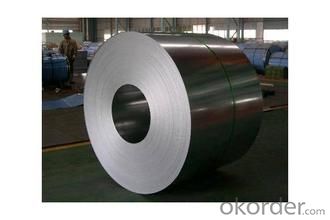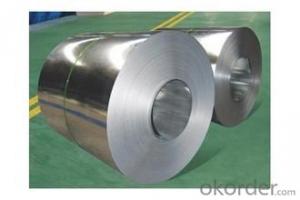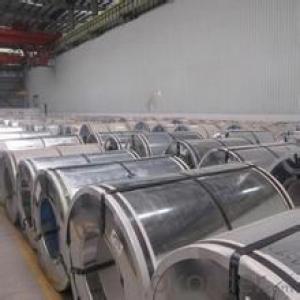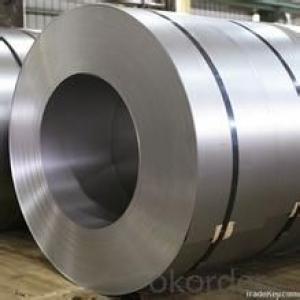good Hot-dip galvanized/ auzinc CSB Steel
- Loading Port:
- Tianjin
- Payment Terms:
- TT OR LC
- Min Order Qty:
- 100 m.t.
- Supply Capability:
- 5000000 m.t./month
OKorder Service Pledge
OKorder Financial Service
You Might Also Like
Description:
Hot-dip aluzinc steel sheet is substrated on cold rolled steel (CRC) in various strength and specification. Coating composition is 55% aluminum in weight ratio, 43.4% zinc, and 1.5% silicon, with excellent corrosion and heat resistance performance.
Specification:
1.Mateials:SGCC,DX51D / DX52D /S250,280GD
2.Size:width:600-1250mm(900mm,1215mm,1250mm,1000mm the most common)
thickness:0.15-2.0mm
length:1000-6000mm,as your require
3.Zinc coating :60-180g( as required)
4.Coil id:508mm
5.Coil weight: 3-5MT(as required)
6. Surface:regular/mini/zero spangle, chromated, skin pass, dry etc.
Applications :
Galvalume Coil widely used for roofing products, It is also the ideal base material for Prepainted Steel Coil.
1. roofing
2. gutters
3. unexposed automotive parts
4. appliances
5. furniture
6. outdoor cabinetry
Images:

The hot-dip process is the process by which steel gets coated in layers of zinc to protect against rust. It is especially useful for countless outdoor and industrial applications.
- Q:I have a new stainless steel trash compactor under a butcher block counter. We refinished the countertop, but unfortunately the person who did it wasn't careful with the orbital sander and sanded the top edge of the stainless steel compactor door, ruining the finish. The sander marks are not deep - just surface scratches - but they are unsightly. Is there any way to restore the finish to the stainless steel without having to buy a new door?
- Scratches are difficult to remove. Most kitchen appliances, sinks, and counters have a polished finish with short directional polishing lines. Restoring a polished finish to its original appearance requires a professional such as a company that specializes in fabricating or polishing stainless steel. If the refrigerator or dishwasher door panel is replaceable, purchasing a new panel is normally more cost effective than professional refinishing. The homeowner may want to consider obtaining replacement panels with angel hair, distressed, swirl, or embossed finish. These finishes help to hide light scratching and can be obtained from companies that specialize in stainless steel finishes. Counters and appliance doors that are not easily removable must be refinished in place. When the counter is refinished, it may have long rather than short polishing lines. If a slightly different finish is acceptable and cost is a consideration, a homeowner can refinish the counter or appliance using a non-metallic abrasive pad such as a Scotch Brite? pad. This can be done by rubbing the surface with the pad using long uniform strokes in the same direction as the current polishing lines. This will not eliminate deep scratches. A professional may offer this finish as a less expensive option. The resulting finish is normally referred to as a hairline or long grain finish. Some appliance companies are starting to offer this finish.
- Q:You have two steel wool pads,one is cut up into little pieces, and the other is whole, and they are both submerged in water. 1.Which steel wool pad will rust quicker?2.How much faster will that pad rust? (estimate+explain the estimate)6.How could you make the steel wool pad rust faster?Please dont tell me to do my homework because I tried, but I bought the wrong type of steel wool
- How to make it rust faster ? Adding oxygen to the water - bubbling air through it. Raising the temperature should make the reaction go faster, but I believe it also reduces the amount of dissolved gas. Adding salt, or an ionic compound like an acid, will accelerate electrochemical corrosion. That usually requires a less active metal, like copper, in contact with the steel, but variations in the composition of the steel may be sufficient to promote corrosion.
- Q:My mother is in a weilding class, and today she accidentally welded Galvanized Steel. She doesn't feel good and she wants to know what the symptoms are for Galvanized Poisoning from breathing in the Fumes. Please help, I am worried for her.
- Galvanized steel is nothing more than regular steel with zinc added. However, unless you wear the proper gear or ventilate the fumes away, the zinc can cause heavy metal poisoning. As someone who has suffered from it before, usually the symptoms are an upset stomach, feeling queasy, diarrhea, and sometimes hallucinations. If it is bad, you start getting joint pain, a metallic taste in your mouth, and develop a fever. Usually, you can treat mild zinc poisoning by drinking lots of fluids and flushing out your system as much as possible. Still, if the problems persist for more than an hour or so, it can be lethal with many blacksmiths having died as a result of it. If she still feels bad, call a poison control center and tell them she breathed in zinc fumes. They will probably tell you to go to the ER to start treatment. It is not something you wait out.
- Q:i have been playing with hand me down graphite shaft irons and wedges. i was wondering if someone of my stature (5'3, 90 lbs., 12 years old) should be using steel shafted irons. i can definately swing them im just wondering if they are better for making contact
- It depends on your swing speed. If you have a faster swing speed and notice you are consistently hitting high with your irons and having some trouble with accuracy, you will benefit from playing steel shafted irons. If your swing speed is on the slower end of the spectrum, stick with the graphite irons for a couple more years until you swing has developed and you are hitting farther.
- Q:Hey do you know what is Steel Arch Building and how it looks like exactly??
- Typically, okorder /
- Q:How are steel coils inspected for surface finish variations?
- Steel coils are inspected for surface finish variations using visual examination, mechanical methods such as gauges and calipers, and non-destructive testing techniques like magnetic particle inspection or ultrasonic testing.
- Q:How are steel coils used in the production of electrical equipment?
- Steel coils are used in the production of electrical equipment as they serve as the core material for various components, such as transformers and inductors. The magnetic properties of steel make it ideal for creating a magnetic field, allowing for efficient energy transfer and voltage regulation. By winding the electrical wires around the steel coils, the magnetic field can be generated, enabling the proper functioning of electrical devices and equipment.
- Q:How are steel coils protected from mechanical damage?
- Steel coils are protected from mechanical damage by using various methods such as wrapping them with protective materials like plastic or paper, using suitable packaging and strapping techniques, and storing them in a controlled environment to prevent any potential impacts or collisions.
- Q:What are the dimensions of steel coils?
- The dimensions of steel coils vary depending on factors such as the specific type of steel, the intended use, and industry standards. Generally, steel coils can range in width from a few inches to several feet, with thicknesses typically ranging from a fraction of an inch to several millimeters. The inner diameter of a steel coil can also vary, with common sizes being 20 inches and 24 inches. Ultimately, the dimensions of steel coils are determined by the specific needs and requirements of the end user.
- Q:What are the different methods of tempering steel coils?
- There are several different methods of tempering steel coils, each with its own advantages and disadvantages. Some of the most common methods include: 1. Air cooling: This is the simplest and most common method of tempering steel coils. The coils are heated to a specific temperature and then allowed to cool naturally in ambient air. This method is relatively quick and cost-effective, but it can result in uneven cooling and may not provide as precise control over the final properties of the steel. 2. Water quenching: In this method, the steel coils are heated and then rapidly cooled by immersing them in a bath of water. Water quenching provides a more rapid and controlled cooling rate than air cooling, resulting in greater hardness and strength. However, it can also lead to increased distortion and the formation of internal stresses in the steel. 3. Oil quenching: Similar to water quenching, oil quenching involves immersing the steel coils in a bath of oil to rapidly cool them. Oil quenching provides a slower and more uniform cooling rate compared to water quenching, resulting in reduced distortion and internal stresses. However, it also produces slightly lower hardness and strength compared to water quenching. 4. Salt bath quenching: This method involves immersing the steel coils in a heated bath of molten salt to rapidly cool them. Salt bath quenching provides an even and controlled cooling rate, resulting in improved hardness and strength compared to air or water quenching. However, it requires specialized equipment and may not be suitable for all types of steel. 5. Induction hardening: In this method, the steel coils are heated using an induction heating process and then rapidly cooled using either air, water, or oil quenching. Induction hardening allows for precise control over the heating and cooling process, resulting in specific hardness and strength properties in desired areas of the steel. However, it requires specialized equipment and is typically used for specific applications or parts of the steel coils. Overall, the choice of tempering method depends on various factors such as the desired properties of the steel coils, the type of steel being used, and the specific requirements of the end application.
1. Manufacturer Overview |
|
|---|---|
| Location | |
| Year Established | |
| Annual Output Value | |
| Main Markets | |
| Company Certifications | |
2. Manufacturer Certificates |
|
|---|---|
| a) Certification Name | |
| Range | |
| Reference | |
| Validity Period | |
3. Manufacturer Capability |
|
|---|---|
| a)Trade Capacity | |
| Nearest Port | |
| Export Percentage | |
| No.of Employees in Trade Department | |
| Language Spoken: | |
| b)Factory Information | |
| Factory Size: | |
| No. of Production Lines | |
| Contract Manufacturing | |
| Product Price Range | |
Send your message to us
good Hot-dip galvanized/ auzinc CSB Steel
- Loading Port:
- Tianjin
- Payment Terms:
- TT OR LC
- Min Order Qty:
- 100 m.t.
- Supply Capability:
- 5000000 m.t./month
OKorder Service Pledge
OKorder Financial Service
Similar products
New products
Hot products
Related keywords































